YuYu interview Musashimaru Koyo
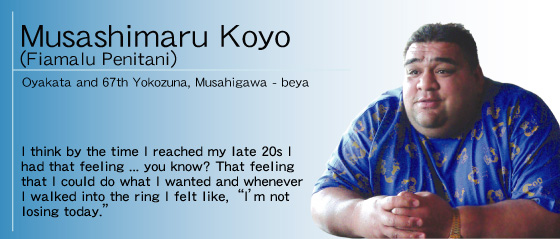
| —— I have to say, watching you and all the sumo greats of the ‘90s; Akebono, Wakanohana, Takanohana, was a real pleasure. How special was it being a part of that “golden age” of sumo? It was a great time. You won’t see a time like that again for a long long time. Maybe never. Everybody is still talking about it and trying to compare the guys now to our time. —— You guys are defi nitely a tough act to follow. 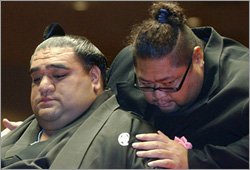
Two Hawaiian sumo legends, Musashimaru (L) and Konishiki (R), confer during Musashimaru’s ceremonial knot-cutting at Tokyo’s Ryogoku Kokugikan. © Kyodo
It’s tough to compare different eras in any sport — they’re all different. People want to compare then and now, but the oyakata say there is no comparison. We had four yoko-zuna. That was special, something that happens maybe once in a lifetime, and I feel very fortunate to have been a part of that. It’s hard to describe the feeling…the excitement of it all. —— I guess that makes your 55- tournament streak even more impressive! Thanks. For something over ten years I went without having a losing tournament record. I don’t know if someone will break it someday, but it will be there for quite a while. It will be interesting to see if someone can do it. —— It seemed the fi nal days of every basho always came down to the four of you. Did that raise the level of sumo? Definitely! We took it to the top! Everyday was a challenge and you needed to be at the top of your game, be at your peak, because otherwise you didn’t have a chance. You were never going to make it to the end of the tournament if you weren’t on top of your game. —— Did any one sekitori stand out as your greatest rival? 
Musashimaru in action during the Kyushu Grand Sumo Tournament.© Kyodo
Tournaments weren’t so much about a rivalry. It was like a day-by-day thing. You’ve got to get by this guy today, and then the next day, another guy. And you’ve got to make it to the last 6 or 7 days. We had 4 yokozunas and about 5 ozeki, so the last week you had matches against nothing but the top guys and everyday was tough. The fi rst half of the basho was tough too, because if you loose even one your out already! Everyone’s level was so high. With so many top sumo, lose in the fi rst half of the draw, make one mistake, and chances are you’re out. —— Was the beginning of a tournament more dangerous or was it the end? Both! But it was different. The beginning was dangerous because the feeling wasn’t quite there yet; it still felt a little bit too much like practice. When you go into a tournament it’s a whole new ballgame. The intensity is higher and because you have to wrestle in the evening, when you are used to practicing in the morning, it throws you off. We’re used to sleeping in the afternoon, but you’ve got to get up, then wake yourself up again to compete. The fi rst half is important because that’s when you get into the rhythm of the tournament and it just continues. The end was tough because of the competition. —— So once you get into the rhythm it became a little easier. Yeah, the fi rst half it’s tough to pick yourself back up again. —— Did you feel that’s when the big guys were more likely to be upset? 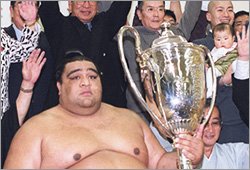
Musashimaru proudly holding a hard earned Emperor’s Cup, one 12 such tournaments he captured during his sumo career. © Kyodo
Right, because you might catch them before they get going. It always depends on the day. You feel good one day and the next day you’ve got a sore stomach, a nagging injury. Something comes up. Things don’t always go well for you. For me the easiest guys to wrestle were the oshizumo guys, the guys that push. Because if they don’t push they can’t win! So they got to come and that’s a lot easier for me. —— I know Hawaii has a great sumo tradition, how did you get started? I was recruited. See, when I was in high school I used to wrestle and play defensive line on the football team. I was a little over the weight classification for wrestling and so my coach said I should try sumo. He knew some guys and introduced me. I was 290 pounds and the scouts liked that, so I thought, “Okay, I’ll give it a try.” That’s how I got started. —— Were you a good football player? I wasn’t a bad football player (smiling)…I was good enough to make the all-star team, but coach thought I’d be better at sumo. The NFL was a dream when I was playing high school football. I’d still like to go up against the best linemen in the NFL. —— Speaking of the NFL, I’ve heard rumors that couple NFL guys came and tried their hand at sumo, how did they do? I’ll tell you the truth (smiling and shaking his head) no! No, they just couldn’t get it. —— I imagine the early days in Japan weren’t easy for a young sumo from Hawaii, learning your sport and a new culture. When did you feel that you actually became a sumo? Yeah, the early days were tough. I was homesick, couldn’t speak the language, missed my friends and family, same as anyone. I think by the time I reached my late 20s I had that feeling…you know? That feeling that I could do what I wanted and whenever I walked into the ring I felt like, “I’m not losing today.” —— What about your friends and family, how did they react when, just after high school, you told them you were moving to Japan to become a sumo?。 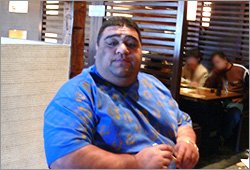
A more relaxed Musashimaru during his recent visit to LA at Gyukaku restaurant in Torrance.
Yeah, they didn’t want me to go. Half of them wanted me to do it. Everyone else was kinda shocked and didn’t want me to leave. But I went and gave it a shot. —— They all must have been proud with all you’ve accomplished. Oh yeah, they’re happy. —— You’ve always had a reputation for training hard, did you bring anything special or different to your workouts? No, not really. Everyone does their own thing. I just worked hard at what I did. Whatever I do — I do more! I give more of myself and do the extra things. —— You always hear athletes talking about giving 110%, how about you? For me it would be more like 220%! When I trained, I’d go all day, from early in the morning through the afternoon and into the night. Training, practice, and preparation to perform at the highest level in professional sumo…it’s a 24-hour a day job! I still train some, but I keep it light so I don’t bulk up. —— Looking back, each sumo has a particular style or strength, what do you think yours was? My strength was my drive. I could keep their hands off my mawashii compared to some of the other guys and that’s where my size helped me. —— So as you grew as a sumo and in size, were you able to do those things more naturally? Right. As the years went by I picked up more technique and I felt that I could do more. By the end of my career I felt comfortable doing almost everything; grab belts, push, whatever. —— Did you have a favorite kimarite or technique? Oh yeah, the underarm, the right-hand in migi-sashi. —— Of course, technique, strength, power and skill are important, but at the highest levels many of your competitors had similar talent, so how much of competing in sumo is mental? It’s huge! I’d say 90%. The physical side of things you work on everyday and that prepares you, but when a tournament starts it’s all on you. You’ve got to have the mental edge or it’s over. There may be a number of guys that are strong, but not everyone has the mental edge. That’s why you’ve got to work on it everyday during practice. When you practice it should be like your going to a tournament. That’s how you’ve got to approach it…just like you’re in a tournament. That way your prepared and you don’t have to think—it becomes second nature. In a match, everything happens so fast, you don’t have time to think—just act! I think it gives you an advantage. —— So, as they say in some sports, you’ve got to practice like you play. Yes. It’s the same thing. Just like football or wrestling…if you don’t do it the right way when you’re practicing, it won’t happen in the ring. So you can’t hold back. —— With the mental part being so big…you must be a genius! (laughing) 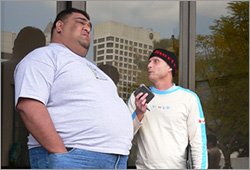
A gracious Musashimaru shares his insights on sumo, past, present and future.
(laughing) No, I’m not a genius. I’m an average guy that worked very hard and kept working hard at my job. I just kept at it, working hard— that’s how I was brought up. My parents always taught me to work hard and take things as they come. —— Since sekitori all go to the same basho, do you get the opportunity to develop personal relationships with any of your opponents? No, it’s not really there, at least not when your competing. But since becoming oyakata we get to talk a lot more now. When we were wrestling everybody was more or less on their own, but now that we’ve finished everybody has a little bit more of a chance. We talk when we see each other at the tournaments and at whatever events or meetings there are. —— Can you share a little bit about some of the sumo tradition? Sumo has a great tradition and I respect that, but I didn’t pay as much attention to that as to my sumo! I was there to win. My energy and focus had to be on what I could control for me to win each match and tournament I entered. Everything else was all right, but it’s not my business or for me to decide. I just focused on what I had to do to win. That’s what my job was and that’s all everybody really wanted from me—to win. Not the traditions. —— Any matches or particular sumo that stood out? It was always great going up against Takanohana, a challenge. He may have been the greatest sumo I went up against. —— How about the new generation of sumo like Asashoryu? How does he rank compared to the guys you used to go up against? He’ good; he’s a yokozuna, but he’s not big like the guys I competed against. Everybody is trying to compare him to our time. He’s good so let him enjoy it. I definitely think he would have had a tougher time back then. I don’t know why, but there are not so many big guys now. We should have some. It’s no fun watching small guys playing in the ring, ya know? We’ve gotta get some of those big boys out there. The big boys can bang; we’ve just got to find the right guys to get back into that ring. —— After such an illustrious career and so many victories, what finally led to your retirement? Injury. My left wrist was the main reason; I just didn’t have any power in my left shoulder after that. So I didn’t think I could maintain the responsibility that a grand champion has. —— Do you feel that a big responsibility has been lifted off of you? Definitely more relaxed. I don’t have this top knot (pointing to his head in reference to a sumo’s chonmage or hair style) no more. —— So now that you’ve become an oyakata, what are your responsibilities? I’ve become oyakata, but I still have my oyakata above me, so I’m still in training. It’s really a lot of the same things, just that now I don’t have to train—all I have to do is talk. Coaching in the morning is my main responsibility, that’s my focus. —— So how is it working with the younger guys that might not have your immense talent and drive? That’s what I’m there to teach them and show them what they can achieve. I’m there to help them get better, how to improve their technique and to teach them things that are beyond techniques, like how to work hard and concentrate. But, not everybody is born with it, so you’ve got to work at their level so they are not overwhelmed. Starting at that level, then you add things, little by little, so they can get better. You can’t just punish a guy all the time and expect him to learn everything all at once. You’ve got to see where they are and then build on that. —— What do you think about the upcoming US Sumo Open and amateur sumo in general? Do you enjoy it? 
US Sumo guests and participants during a gathering in LA’s Little Tokyo.
I’d like to see a good sumo tournament and see all of them do their best for a great tournament. I enjoy it very much, but I think they need more knowledge about the rules. Amateurs in Japan are at a higher level than this. My opinion is that sumo in Japan have a better understanding of the sport and the techniques. There is so much more than just pushing or pulling your opponent out. I’d like to teach them those points. This tournament some Japanese sumo here, so hopefully the others can learn from them too. —— Now that you have a little more free time, what do you like to do? I like to listen to music, go to the beach and hang out, or go to the park and just relax. —— What’s next for sumo? Are there any other great Hawaiian sumo on the horizon? Not yet, but I’m working on it. We are trying to get back on the right track. It’s one of my personal interests and very important to me. People everywhere love sumo, so I’d like it to spread here and around the world. We just need to get more athletes involved. That’s why, when I’ve got the chance, I like coming out to events like this (US Sumo Open) and the Grand Sumo Las Vegas tournament. I want to share this sport with the world. I want everyone to have the chance to love it like I do. (05-01-2006 issue, Interviewed by Terry Nicholas) |

